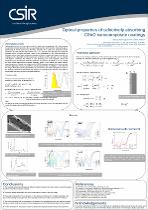JavaScript is disabled for your browser. Some features of this site may not work without it.
- ResearchSpace
- →
- Research Publications/Outputs
- →
- Conference Publications
- →
- View Item
| dc.contributor.author |
Roro, Kittessa T

|
|
| dc.contributor.author |
Tile, N

|
|
| dc.contributor.author |
Forbes, A

|
|
| dc.date.accessioned | 2011-10-03T14:44:25Z | |
| dc.date.available | 2011-10-03T14:44:25Z | |
| dc.date.issued | 2010-12 | |
| dc.identifier.citation | Roro, K.T., Tile, N and Forbes, A. 2010. Optical properties of selectively absorbing C/NiO nanocomposite coatings. International Workshop on Advanced Materials and Technologies for Global Energy and Environmental Challenges, CSIR International Convention Centre, Pretoria, 6-8 December 2010 | en_US |
| dc.identifier.uri | http://hdl.handle.net/10204/5192 | |
| dc.description | International Workshop on Advanced Materials and Technologies for Global Energy and Environmental Challenges, CSIR International Convention Centre, Pretoria, 6-8 December 2010 | en_US |
| dc.description.abstract | Nanocomposite thin films are widely used for solar thermal applications. Using carbon nanoparticle containing metal oxide as a spectrally selective solar absorber coating has grown significantly in recent years. Recently, Katumba et al. have compared carbon embedded in three different metal oxides (SiO2, ZnO, and NiO) and deposited on aluminium substrate using a sol-gel technique. Some of the advantages of this novel technique to fabricate carbon-metal oxide composite coatings are that it is simple and easy to control, the coatings can be deposited at ambient pressure conditions, and the process is low in material consumption. Therefore, the method is very promising and could hopefully reduce the production costs for spectrally selective absorbers. According to Katumba et al., among the three carbon/metal oxide composite materials, carbon in NiO matrix has shown superior optical properties. Although the feasibility of the C/NiO composite coatings for a selective solar absorber application has been published, a detailed systematic investigation on the effect of the sol-gel fabrication process parameters on the structural and optical properties as well as the optimized theoretical design were not reported. It is therefore the purpose of this work to theoretically optimize the C/NiO composite coatings. | en_US |
| dc.language.iso | en | en_US |
| dc.relation.ispartofseries | Workflow request;5988 | |
| dc.subject | Nanocomposite films | en_US |
| dc.subject | Carbon nanoparticle | en_US |
| dc.subject | Solar absorber | en_US |
| dc.subject | Sol-gel | en_US |
| dc.subject | NiO matrix | en_US |
| dc.subject | C/NiO | en_US |
| dc.subject | Composite coatings | en_US |
| dc.subject | Environment | en_US |
| dc.title | Optical properties of selectively absorbing C/NiO nanocomposite coatings | en_US |
| dc.type | Conference Presentation | en_US |
| dc.identifier.apacitation | Roro, K. T., Tile, N., & Forbes, A. (2010). Optical properties of selectively absorbing C/NiO nanocomposite coatings. http://hdl.handle.net/10204/5192 | en_ZA |
| dc.identifier.chicagocitation | Roro, Kittessa T, N Tile, and A Forbes. "Optical properties of selectively absorbing C/NiO nanocomposite coatings." (2010): http://hdl.handle.net/10204/5192 | en_ZA |
| dc.identifier.vancouvercitation | Roro KT, Tile N, Forbes A, Optical properties of selectively absorbing C/NiO nanocomposite coatings; 2010. http://hdl.handle.net/10204/5192 . | en_ZA |
| dc.identifier.ris | TY - Conference Presentation AU - Roro, Kittessa T AU - Tile, N AU - Forbes, A AB - Nanocomposite thin films are widely used for solar thermal applications. Using carbon nanoparticle containing metal oxide as a spectrally selective solar absorber coating has grown significantly in recent years. Recently, Katumba et al. have compared carbon embedded in three different metal oxides (SiO2, ZnO, and NiO) and deposited on aluminium substrate using a sol-gel technique. Some of the advantages of this novel technique to fabricate carbon-metal oxide composite coatings are that it is simple and easy to control, the coatings can be deposited at ambient pressure conditions, and the process is low in material consumption. Therefore, the method is very promising and could hopefully reduce the production costs for spectrally selective absorbers. According to Katumba et al., among the three carbon/metal oxide composite materials, carbon in NiO matrix has shown superior optical properties. Although the feasibility of the C/NiO composite coatings for a selective solar absorber application has been published, a detailed systematic investigation on the effect of the sol-gel fabrication process parameters on the structural and optical properties as well as the optimized theoretical design were not reported. It is therefore the purpose of this work to theoretically optimize the C/NiO composite coatings. DA - 2010-12 DB - ResearchSpace DP - CSIR KW - Nanocomposite films KW - Carbon nanoparticle KW - Solar absorber KW - Sol-gel KW - NiO matrix KW - C/NiO KW - Composite coatings KW - Environment LK - https://researchspace.csir.co.za PY - 2010 T1 - Optical properties of selectively absorbing C/NiO nanocomposite coatings TI - Optical properties of selectively absorbing C/NiO nanocomposite coatings UR - http://hdl.handle.net/10204/5192 ER - | en_ZA |






